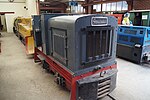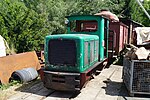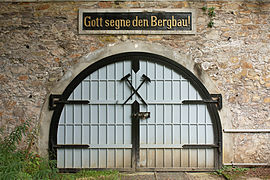Fortuna pit (Solms)
| Fortuna | |||
|---|---|---|---|
| General information about the mine | |||
| The mouth of the new deep tunnel (1908) | |||
| Funding / total | ~ 4.8 million tons of t | ||
| Rare minerals | Magnetite | ||
| Information about the mining company | |||
| Operating company | Prince of Solms-Braunfels; Friedr. Krupp AG; Sieg-Lahn / Harz-Lahn-Bergbau AG; Barbara raw material companies | ||
| Employees | 43 (1983) | ||
| Start of operation | 1847 | ||
| End of operation | March 3, 1983 | ||
| Successor use | Visitor mine | ||
| Funded raw materials | |||
| Degradation of | Iron ore | ||
| Greatest depth | 250 m | ||
| Geographical location | |||
| Coordinates | 50 ° 34 '28.2 " N , 8 ° 25' 23" E | ||
|
|||
| Location | Oberbiel | ||
| local community | Solms | ||
| District ( NUTS3 ) | Lahn-Dill district | ||
| country | State of Hesse | ||
| Country | Germany | ||
| District | Lahn dill | ||
The Fortuna mine, which was closed in 1983 in a wooded area north of Solms-Oberbiel near Wetzlar, is one of the many mines in the Lahn-Dill area . Here was iron ore in the form of hematite (hematite) and limonite (Limonite) mined , as a small Magnetitlager.
The Fortuna mine is a visitor mine and a geo-information center in the Westerwald-Lahn-Taunus Geopark .
history
In 1847 the ore deposits in the later mining area ( mine field ) of the Fortuna mine were first mentioned in the mining authority files . In 1849, the mining area to the prince was Ferdinand Solms-Braunfels awarded that the mine 57 years mainly as a surface mining operation. The first shaft was not sunk until 1900 . From 1878 the iron ore was transported to the Georgshütte blast furnace in Burgsolms by a 3.6 km long cable car . In 1906 the prince sold the Fortuna mine and all other mines, including the Ferdinand mine, to the Friedrich Krupp company in Essen.
1907, a new shaft ( engine shaft II ), initially only up to 40 m sole , drilled. Shortly afterwards, a depth of 150 m was reached. A second cable car was completed in 1908. The ore was now pulled by the mine train from the mine tunnel over the Berghausen – Oberbiel road and unloaded in the so-called dumping hall. After processing , it was taken by cable car to Albshausen station on the Lahntalbahn . This mainly transported the ore to Wetzlar, where Buderus smelted it in the blast furnaces . Between 1908 and 1915 the new deep tunnel was driven and made access to the new shaft possible. About this tunnel drive visitors today in the mine one.
In 1929 a blind shaft was sunk from the 150 m level to the 250 m level. After machine shaft II collapsed in 1943 , a new blind shaft was sunk from the new deep tunnel to the 150 m level. This shaft is also used by visitors to the visitor mine today to get to the 150 m level. In 1953, Harz Lahn Erzbergbau AG took over the mine. In 1954 the main blind shaft was sunk down to the 250 m level. In 1957 the overburden was broken through for days. A new hoist house was built there. In the years 1959/1960 a connecting shaft to the 100 m level was drilled to enable weather control.
In 1962 the mine was closed for the first time, because the main buyers of the ore, including the Krupp company, wanted to use ores from abroad for steel production in the future. A small team remained for decommissioning work. And as early as 1963, operations began again, as the conversion to foreign ores led to problems.
In the following years, wheeled vehicles were used underground and above ground. For underground were LHD purchased and transported daily from 1979 trucks the ore to the station Albshausen. In addition, the ventilation was changed in 1974 and the pit air was discharged by means of fans against the natural air flow through the light hole from 1960.
The end of the mine was in 1981 at the latest, when the Sophienhütte in Wetzlar was the last blast furnace plant in Hesse to be shut down. The Erzabnahme declined progressively, and when on March 3, 1983 ended the last delivery layer were in Grundbachtal 130,000 tons of ore to stockpile .
The Fortuna mine is a protected cultural asset under the Hague Convention .
Visitor mine
On March 16, 1983, the Fortuna Visitor Mine Association was founded. He set himself the goal of preserving the mine as a visitor mine for posterity. In September 1983, however, the pumps were initially switched off, which until then had prevented the pit from sinking due to rising groundwater .
In December, the association was able to obtain a decision from the district and the surrounding towns and communities, according to which the Fortuna mine should actually be preserved for posterity. 1985, after the marshes of the pit, the expansion work for the visitor mining operation could begin. The visitor business was opened on Whit Monday 1987.
Visitors reach the 150-meter level with a hoist cage . A battery-powered mine train takes you 450 m to the north camp saddle . After the trip, the visitors reach an old mining area, where expert guides demonstrate the technique of iron ore mining in the Fortuna mine until it was closed in 1983. Various special tours are also offered away from the normal visitor routes. In addition, the mine house, dumping hall and ore bunker with its museum and the hoisting machine house with the original machine from 1958 offer interesting insights into the working world of miners. The exhibition mine is Geo-Information Center of the Geopark Geopark Westerwald-Lahn-Taunus .
After basic safety-related upgrading in 2010/2011 as well as investments in the museum, infrastructure and surface facilities, the reopening took place on April 16, 2011 as a visitor mine under the new sponsorship of the Geowelt Fortuna e. V . Since then, Fortuna has had around 20,000 visitors a year.
The visitor mine with shaft experience and mine train ride is one of the impressive mining historical relics and is part of the Route of Industrial Culture Central Hesse as well as the European Route of Industrial Culture (ERIH) .
Field and mine railway museum
After the opening of the Fortuna visitor mine in 1987, the Lahn-Dill district became the sponsor of the visitor mine . The Förderverein visitors mine Fortuna eV , which had built up the visitor mine by then, took on the construction of another museum as a new project. The Fortuna Field and Mine Railway Museum (FGF) has been built since 1987 on the former coal mine site of the Fortuna mine .
The work of the members began with the procurement of the first rail vehicles and the construction of an infrastructure in the form of a 600 mm track system and a shelter for the locomotives . In September 1993 - there was now an approx. 100 m long route and a large museum hall - the museum was opened and the first passenger transport for visitors took place.
Today the museum's collection includes over 50 locomotives and over 100 wagons. These include light rail vehicles , mine rail vehicles and small rail vehicles . Every year around six driving days take place, on which visitors can take a trip with the steam locomotive-hauled train on the now 2.5 km long route with a forest section and an uphill section ( gauge 600 mm) and visit the museum.
List of locomotives
| drive | No. | design type | Manufacturer | Type / name | Factory no. | Construction year | image |
|---|---|---|---|---|---|---|---|
| steam | 1 | Bn2t | Henschel | Bouncer | 23170 | 1936 |

|
| 2 | Bn2t | Budich | like Henschel-Riesa | 1029 | 1944 |

|
|
| 3 | Bn2t | OK | 6625 | 1913 |

|
||
| 4th | Bn2t | Krauss | 6616 | 1912 |

|
||
| 5 | Dn2t | Henschel | Brigadelok | 14913 | 1916 |

|
|
| diesel | 10 | Bdm | OK | MD 1 | 7551 | 1937 |

|
| 11 | Bdm | OK | RL 1c | 5462 | 1934 | ||
| 12 | Bdm | Young | EL 105 | 7258 | 1937 | ||
| 13 | Bdm | Parishes | 18/20 | 3364 | 1941 |

|
|
| 14th | Bdm | Parishes | 45/50 | 2483 | 1939 | ||
| 15th | Bdh | Schöma | CFL 45 DC | 2832 | 1964 |

|
|
| 17th | Bdm | The MA | DS 22 | 1387 | 1950 | ||
| 18th | Bdh | The MA | DS 40/1 | 2884 | 1966 | ||
| 19th | Bdm | Ruhrtaler | KML 7 | 2802 | 1949 | ||
| 20th | Bdh | Ruhrtaler | G 22 HL 2 | 3899 | 1968 |

|
|
| 21st | Bdh | Schöma | CHL 40 | 2379 | 1960 |

|
|
| 22nd | Bdm | Deutz | A6M 517 | 27388 | 1940 | ||
| 23 | Bdm | Deutz | MAH 914 | 55952 | 1956 | ||
| 24 | Bdm | Deutz | OME 117 | 12518 | 1934 | ||
| 25th | Bdm | LKM | Ns 2f | 248797 | 1956 | ||
| 26th | Cdm | LKM | V 10 C | 250316 | 1963 |

|
|
| 28 | Bdm | Deutz | MAH 228F | 8431 | 1928 | ||
| 29 | Bdm | LKM | Ns 2f | 248485 | 1954 | ||
| 30th | Bdm | Demag | ML 15 | 2025 | 1937 |

|
|
| 31 | Bdm | Skoda | BND 30 | 2434 | 1956 | ||
| 32 | Bdm | LKM | Ns 1b | 247418 | 1957 | ||
| 33 | Bdm | Parishes | 18/20 | 3365 | 1941 | ||
| 34 | Bdm | Deutz | GZ 30B | 57692 | 1964 | ||
| 35 | Bdh | Deutz | GG 90 B | 56547 | 1957 | ||
| 36 | Bdm | Ruhrtaler | G 90 Ö / V | 3449 | 1956 | ||
| 37 | Cdh | Parishes | Hf 130 C | 4046 | 1943 | ||
| 38 | Bdm | Ruhrtaler | G 90 Ö / V | 3562 | 1958 | ||
| 39 | Bdh | Ruhrtaler | G 90 PDB | 3781 | 1964 |

|
|
| 40 | Cdm | Ruhrtaler | G 100 Z | 3772 | 1963 | ||
| 41 | Bdm | Deutz | OMZ 122 | 39616 | 1941 | ||
| 42 | Bdm | Deutz | MLH 322 G | 16316 | 1936 |

|
|
| 43 | Bdm | Deutz | OME 117 | 12850 | 1934 | ||
| 44 | Bdm | Young | ZL 105 | 6581 | 1936 |

|
|
| 45 | Bdm | Strüver | Rail pen | 1942/1943 |

|
||
| 46 | Bdm | Ruhrtaler | KML 7 | 2731 | 1948 | ||
| 47 | Bdh | Deutz | GG 90 B | 57945 | 1965 | ||
| 48 | Bdh | Deutz | GG 90 B | 56433 | 1957/1987 | ||
| 49 | 2 + Bdh + B | Ruhrtaler | G 160 trio | 3894 | 1969/1996 | ||
| 50 | Bdm | LKM | Ns 2f | 262067 | 1959 | ||
| 51 | Bdm | Young | EL 110 | 11866 | 1955 |

|
|
| 52 | Bdh | Rensmann (Deutz) | D2-9 | 56137 | 1955/1991 | ||
| 53 | Bdm | Young | EL 110 | 6610 | 1936 | ||
| 54 | 1A-A1-ie | The MA | GT 10/2 | 3266 | 1972 | ||
| 55 | Bdm | Parishes | 20/24 | 1669 | 1936 | ||
| 56 | Bdm | Deutz | OME 117 | 36524 | 1941 | ||
| Electric | 60 | Ba | Bartz | BL 1/4 Type 1260 | 1341 | 1958 | |
| 61 | Bo-e | AEG Bartz | HF 1 and GF 08 | 8144/1715 | 1962 |

|
|
| 62 | Bo-e | AEG | EL 5 | 1930 | |||
| 64 | Boa | Bartz | KGA 07-b-05 | U375 | 1968 | ||
| 65 | A1-a | Siemens Schalke | Dismantling | 5199/10944 | 1951 | ||
| 66 | A1-a | AEG Bartz | BL 1/6 | 1417 | 1958 | ||
| 67 | Bo-e | BBC | G 509 | 2781 | 1967 |

|
|
| 68 | BoBo-a | BBA | B 660 | 889 | 1989 |
Mining of the Lahn-Dill area
literature
- Rolf Georg: On a narrow track at the mine. The Fortuna Field and Mine Railway Museum (FGF) (gauge 600 mm). Museum guide. Friends of Fortuna Visitor Mine, Wetzlar 2000.
- Rolf Georg, Rainer Haus, Karsten Porezag: Iron ore mining in Hesse. Historical photo documents with explanations. 1870-1983. Friends of the Fortuna visitor mine , Wetzlar 1985, ISBN 3-925619-00-3 .
- Hansjoachim Lippert: The Roteisenstein border camp from the turn of the Middle-Upper Devonian in the Dill-Mulde. Observations and thoughts on the formation of ore and secondary rock. In: Journal of the German Geological Society. Vol. 104, 1952, ISSN 0012-0189 , pp. 260-276.
- Hansjoachim Lippert: From the Roteisenstein mining on Lahn and Dill. In: Journal of the German Society for Geosciences. Vol. 105, 1953, pp. 20-24.
- Karsten Porezag: Wetzlar mining town. Wetzlardruck GmbH, Wetzlar 1987, ISBN 3-926617-00-4
- Tim Schönwetter: The Fortuna mine - monument to the Hessian iron ore mining . In: Zeitschrift Industriekultur 1.2018, pp. 16–19.
Web links
- Homepage Fortuna visitor mine
- Homepage field and mine railway museum
- Website Geopark Westerwald-Lahn-Taunus
- Monument protection Hessen: Fortuna pit
- Route of industrial culture in Central Hesse
Individual evidence
- ^ Print edition of the Dill newspaper (June 8, 2011)
- ↑ Lahn-Dill-Kreis appoints the association as sub-tenant of the visitor mine Grube Fortuna ( Memento from September 15, 2013 in the Internet Archive ), message from the Weilburger Nachrichten of March 14, 2011
- ↑ On the trail of ore construction in Frankfurter Allgemeine Zeitung . April 14, 2011, p. 54.
- ↑ Fortuna Field and Mine Railway Museum: Steam locomotives.
- ↑ Fortuna Field and Mine Railway Museum: Diesel locomotives.
- ↑ Fortuna Field and Mine Railway Museum: Electric locomotives.




